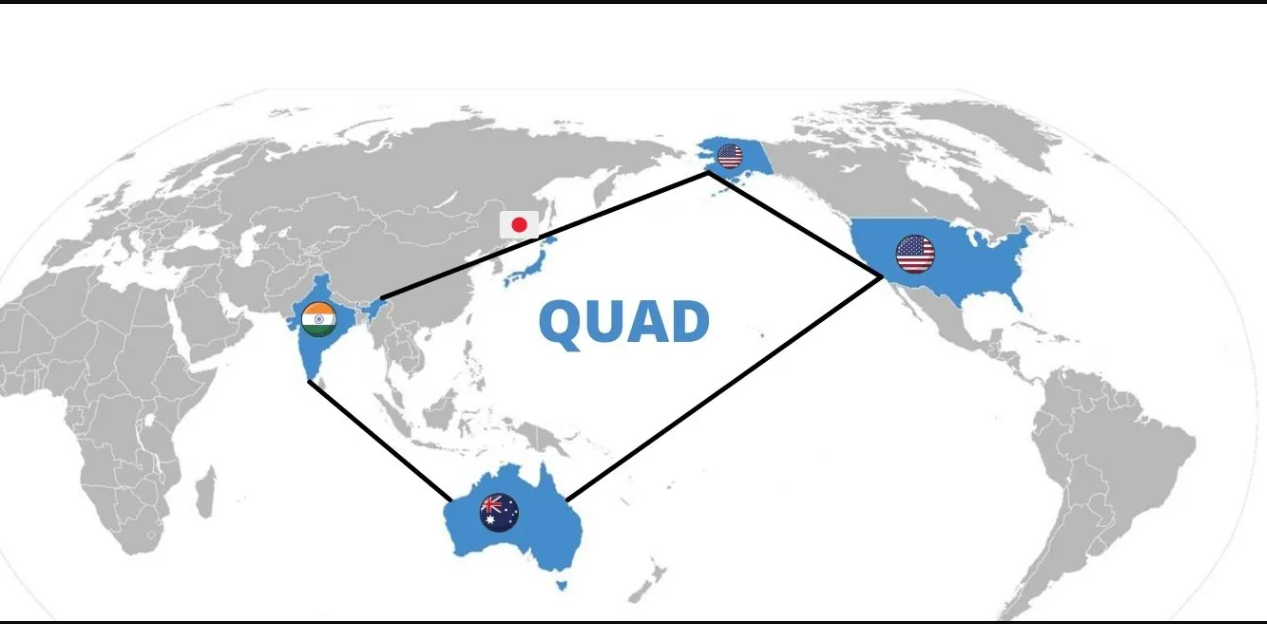
Earlier this month, it was announced that the next Quad summit will be held this May in Japan to discuss the ongoing crisis in Ukraine. The Quad, formally known as the Quadrilateral Security Dialogue, is a strategic security dialogue composed of the heads of state from Australia, India, Japan, and the United States. Most recently, the bloc has collaborated on tackling the COVID-19 pandemic, climate change, various transnational cybersecurity threats, as well as modern infrastructure projects. Examples of collaboration include the Quad Vaccine Partnership, in which the Quad countries pledged to donate over a billion vaccine doses globally, and the Quad Infrastructure Coordination Group, through which Quad partners have given almost $50 billion for thousands of infrastructure projects in the Indo-Pacific. The Quad has also officially announced plans to collaborate to encourage education & 5G deployment, and in using satellite data to analyse climate change.
The emergence of the Quad started off on rocking footing. Though established in 2007 by Japanese Prime Minister Shinzo Abe, the Quad ended in 2008 after then-Australian Prime Minister Kevin Rudd pulled out of the alliance. According to The ASPI Strategist, the alliance went dormant in 2008 “due to Australia’s and India’s reluctance to undermine what had been healthy bilateral relations with China.” It wasn’t until 2017 that it was re-established after Abe, Indian Prime Minister Narendra Modi, Australian Prime Minister Malcom Turnbull and U.S. President Donald Trump agreed to revive it at the 2017 ASEAN Summits in Manila. In both 2007 and in 2017 what brought these four together was China’s growing dominance and a focus on maintaining a “free and open Indo-Pacific,” with analysts asking if the Quad was aspiring to become an “Asian NATO.”
After it became clear that the reinstated Quad had more lasting power than its first iteration, Chinese Foreign Minister Wang Yi, among other high profile Chinese officials have been criticizing the Quad for their anti-China bias, describing the bloc as a U.S.-led effort to “contain China” and stymie China’s Belt and Road Initiative. Wang Yi has claimed that the Quad aims to “trumpet the Cold War mentality and to stir up confrontation among different groups and blocs and to stoke geopolitical competition. What it maintains is the dominance and hegemonic system of the United States.” In a similar vein, Geng Shuang in 2017, then China’s deputy director of the Foreign Ministry’s Information Department, stated that “such multilateral initiatives should promote cooperation among countries concerned and not be turned into exclusionary frameworks."
We have only to look at former U.S. Secretary of State Mike Pompeo’s October 2020 statement in Tokyo to understand that, while the other members of the Quad might not be blatantly calling out countering China as their key focus, the U.S. certainly has no qualms in doing so: “As partners in this Quad, it is more critical now than ever that we collaborate to protect our people and partners from the Chinese Communist Party’s exploitation, corruption, and coercion… We’ve seen it in the South China Sea, in the East China Sea, the Mekong, the Himalayas, the Taiwan Straits. These are just a few examples.”
What is preventing the other alliance members from openly highlighting China as their common challenge? According to the South China Morning Post, they, along with other countries in the region, have good reason to be reluctant to jeopardize ties with China. One example of this is vaccine diplomacy during the COVID-19 pandemic. In what is seen as an attempt to counter this dependency on China, Vietnam, South Korea, and New Zealand have been added to the Quad as supplementary members, called the “Quad Plus” and the Quad’s focus on combatting the pressures of the pandemic has been highlighted. The Quad Plus allows for the four global powers that have been working on a macro-level cooperative framework to work with emerging regional players on more focused, niche joint initiatives. An example of where these Quad Plus economies may play an extremely relevant role is in the Quad’s Supply Chain Resilience Initiative, which aims specifically to reduce Indo-Pacific dependence on Chinese supply chains. There have been hints that the 10 members of the Association of Southeast Asian Nations may be invited to join the supply chain initiative.
Important to note is that on other matters of global security and diplomacy, Quad members are not all in agreement. The recent Quad meeting discussing the Russian invasion of Ukraine highlighted this. Of the four countries, India is the only one that has not yet condemned the Russian state, and is even facing the threat of sanctions from the U.S. on this issue. The South China Morning Post even went so far as to call China and India “reliable partners for Russia and acting as valves to release the pressure from Western sanctions.” As India continues to face disputes with China over the LAC, it remains to be seen how the South Asian nation will balance competing pressures as it aims to maintain some level of diplomatic neutrality.
We know that U.S. President Joe Biden is expected to visit Japan at the end of May this year for the next Quad Summit. The agenda for the in-person Summit is focused on responding to the crisis in Ukraine. Given that Chinese trade with Russia has increased 12% since the launch of the Russian invasion in March of this year, and U.S. officials claiming that China is militarily supporting Russia, it seems clear that the Quad’s anti-China stance will only be reiterated. What response China may have to the Quad Summit, and what declarations may be made by the Quad alliance remain to be seen.
